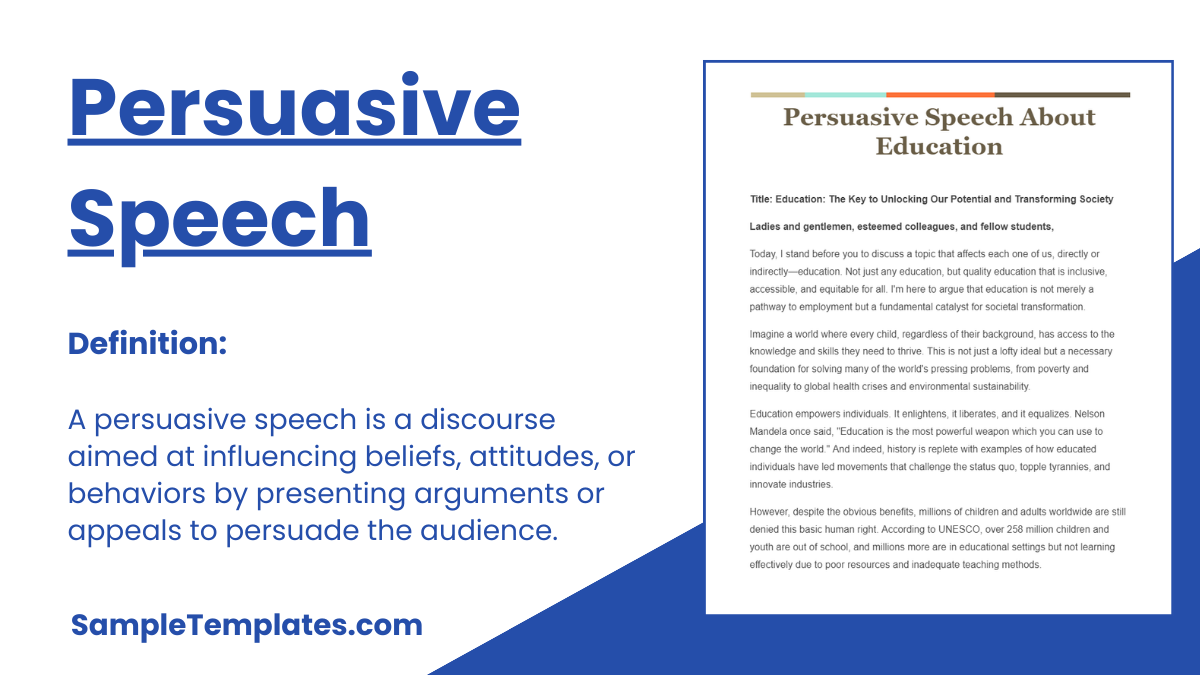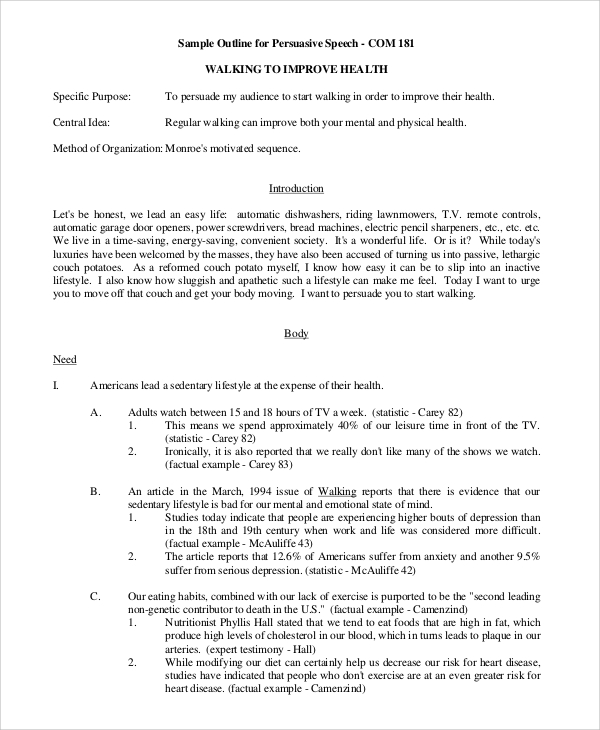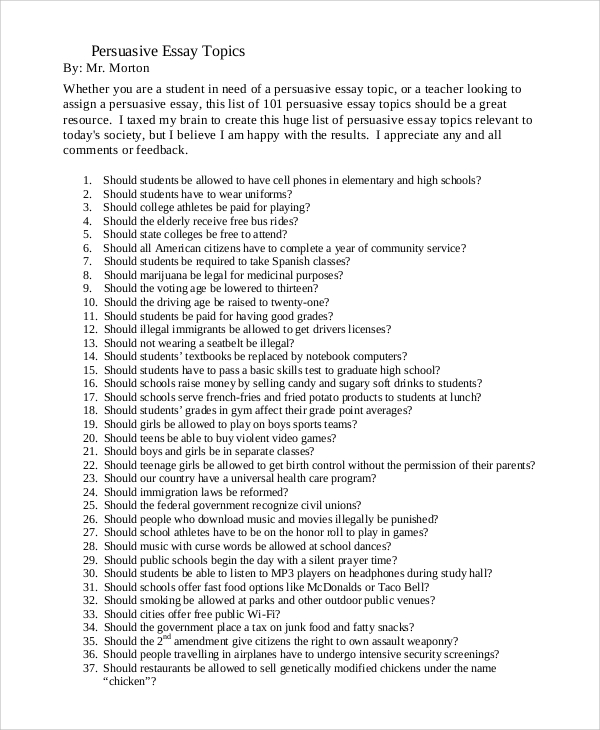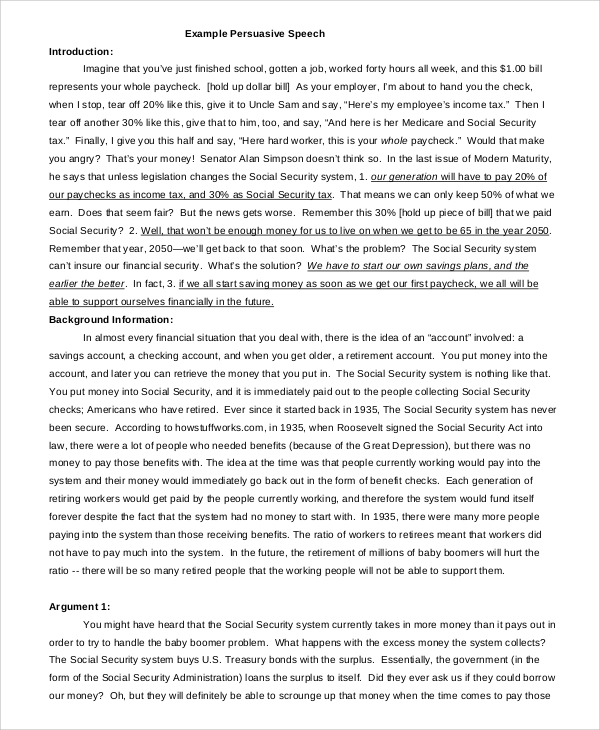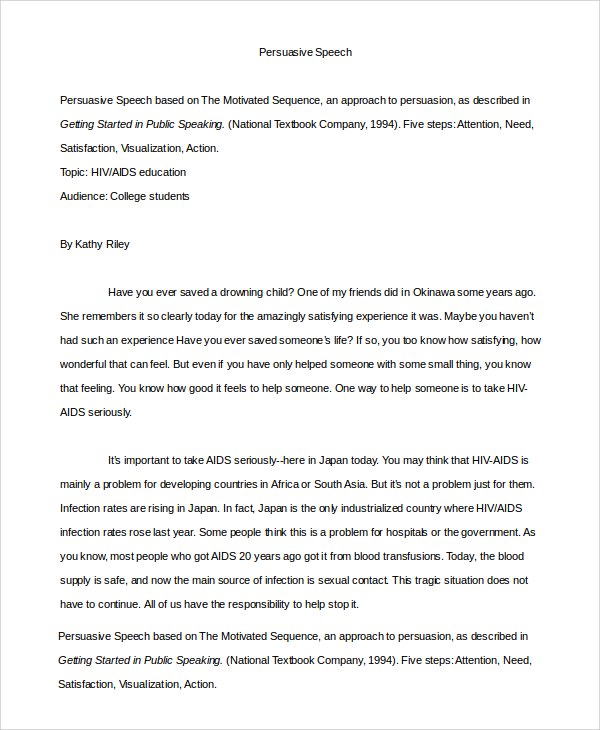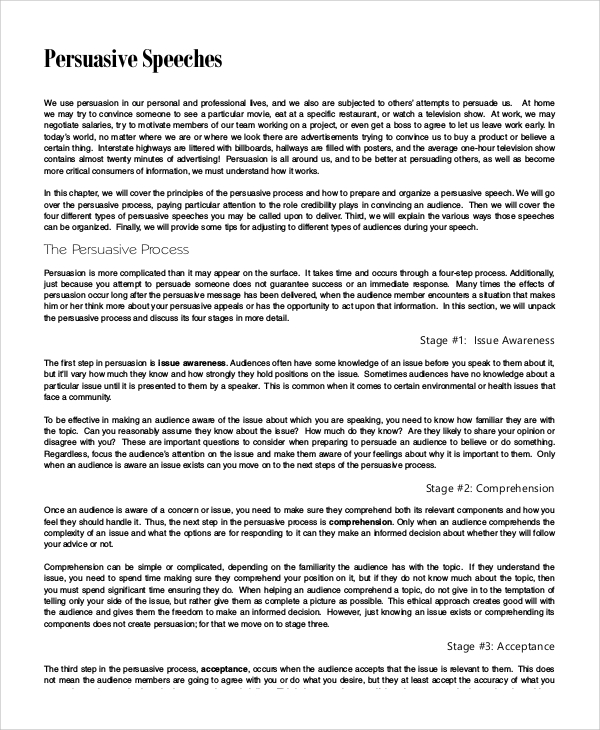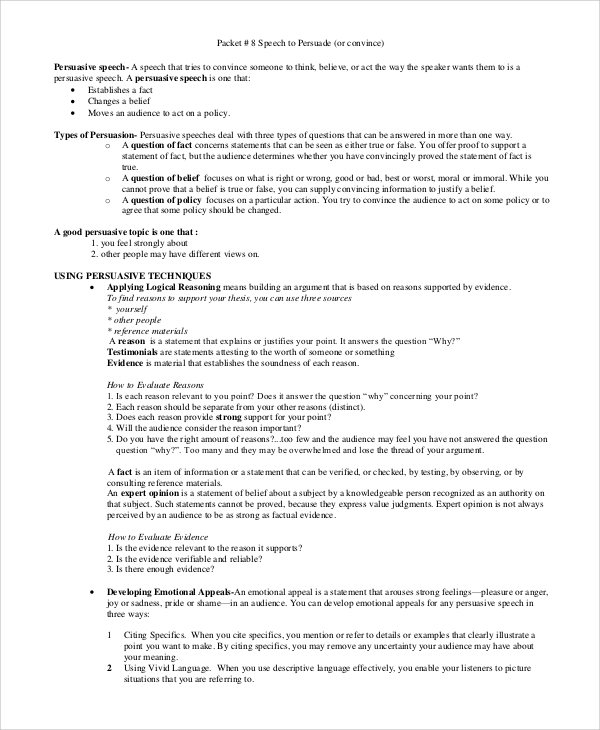A persuasive speech is a lot different from a normal speech. In this, the person delivering the lecture on a particular topic is burdened with the responsibility of pursuing the listeners to be on the on the same page as himself. The Sample Speech Examples is well outlined for the easy understanding of listeners. A sample speech example follows Monroe’s Motivated Sequence of five steps which is the background speech preparation, speech introduction, speech body, conclusion and speech references.
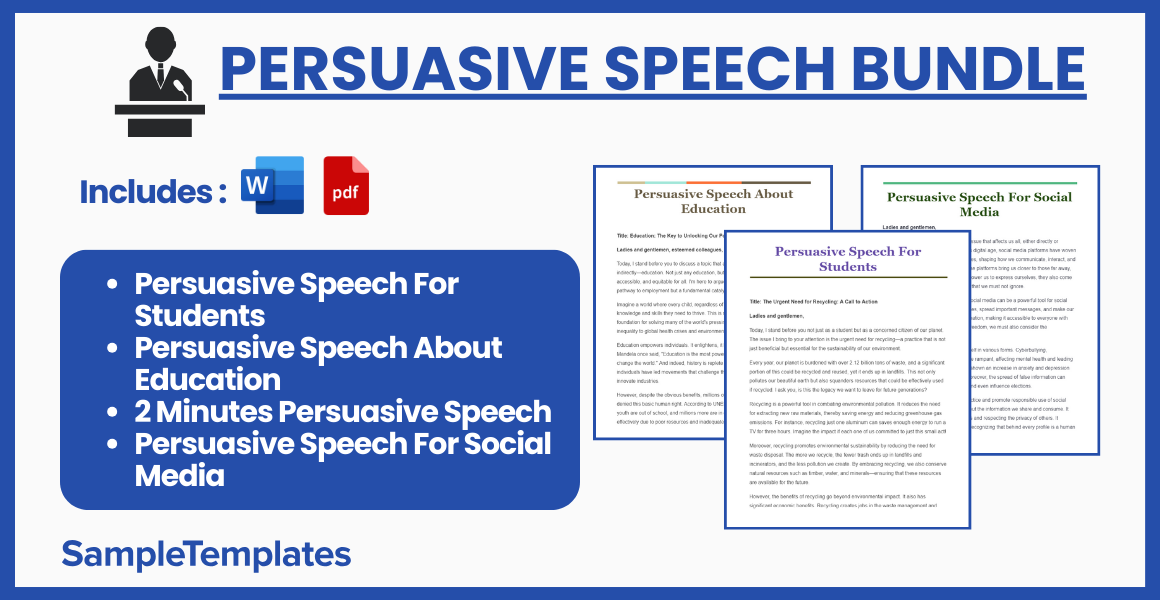
Download Persuasive Speech Bundle
Persuasive Speech For Students
Title: The Urgent Need for Recycling: A Call to Action
Ladies and gentlemen,
Today, I stand before you not just as a student but as a concerned citizen of our planet. The issue I bring to your attention is the urgent need for recycling—a practice that is not just beneficial but essential for the sustainability of our environment.
Every year, our planet is burdened with over 2.12 billion tons of waste, and a significant portion of this could be recycled and reused, yet it ends up in landfills. This not only pollutes our beautiful earth but also squanders resources that could be effectively used if recycled. I ask you, is this the legacy we want to leave for future generations?
Recycling is a powerful tool in combating environmental pollution. It reduces the need for extracting new raw materials, thereby saving energy and reducing greenhouse gas emissions. For instance, recycling just one aluminum can saves enough energy to run a TV for three hours. Imagine the impact if each one of us committed to just this small act!
Moreover, recycling promotes environmental sustainability by reducing the need for waste disposal. The more we recycle, the fewer trash ends up in landfills and incinerators, and the less pollution we create. By embracing recycling, we also conserve natural resources such as timber, water, and minerals—ensuring that these resources are available for the future.
However, the benefits of recycling go beyond environmental impact. It also has significant economic benefits. Recycling creates jobs in the waste management and manufacturing industries. According to the National Institute of Health, recycling and remanufacturing industries account for over 1.1 million jobs in the U.S. alone.
Despite these benefits, many still question, “Why should I recycle?” The answer is simple: because our planet needs it. We are at a critical point where taking action can mean the difference between a depleted planet and a sustainable one. The choice is ours.
So today, I urge each one of you to take a stand. Start with something as simple as recycling your paper, plastics, and metals. Educate those around you about the importance of recycling. Advocate for policies that support environmental sustainability. Let’s not be the generation that could have done something but chose to do nothing.
In conclusion, recycling is not just a choice; it is our responsibility. It is a vital part of the solution to our environmental crisis. Let us act now, for the earth does not belong to us, we belong to the earth. Let’s start recycling today, for a better tomorrow.
Thank you.

Persuasive Speech About Education
Title: Education: The Key to Unlocking Our Potential and Transforming Society
Ladies and gentlemen, esteemed colleagues, and fellow students,
Today, I stand before you to discuss a topic that affects each one of us, directly or indirectly—education. Not just any education, but quality education that is inclusive, accessible, and equitable for all. I’m here to argue that education is not merely a pathway to employment but a fundamental catalyst for societal transformation.
Imagine a world where every child, regardless of their background, has access to the knowledge and skills they need to thrive. This is not just a lofty ideal but a necessary foundation for solving many of the world’s pressing problems, from poverty and inequality to global health crises and environmental sustainability.
Education empowers individuals. It enlightens, it liberates, and it equalizes. Nelson Mandela once said, “Education is the most powerful weapon which you can use to change the world.” And indeed, history is replete with examples of how educated individuals have led movements that challenge the status quo, topple tyrannies, and innovate industries.
However, despite the obvious benefits, millions of children and adults worldwide are still denied this basic human right. According to UNESCO, over 258 million children and youth are out of school, and millions more are in educational settings but not learning effectively due to poor resources and inadequate teaching methods.
This gap, my friends, is not just an educational crisis; it is a moral one. It diminishes our collective potential and perpetuates a cycle of poverty. An educated populace is a critical prerequisite for fostering economic development, social cohesion, and democratic societies. Education fuels innovation and creativity, drives growth, and builds a resilient society capable of tackling future challenges.
Therefore, I urge each of you, as stakeholders in global development, to prioritize education in your policies and philanthropy. Invest in teacher training, infrastructure, and innovative educational technologies that make learning accessible to all. Support policies that ensure girls and boys, men and women, have equal opportunities to learn and grow. Advocate for education not just as a means to a job but as a pillar of ethical citizenship and a cornerstone of civilization.
Ladies and gentlemen, the road ahead is undoubtedly filled with challenges, but the path is clear. Education is the key. Let us commit here and now to unlocking the potential of every human being through the power of education. Let us harness it as the catalyst for change our world so desperately needs.
In closing, remember that by empowering one educator, you can influence hundreds of minds. By educating one child, you can change a community, and by transforming education, you can change the world.
Thank you.
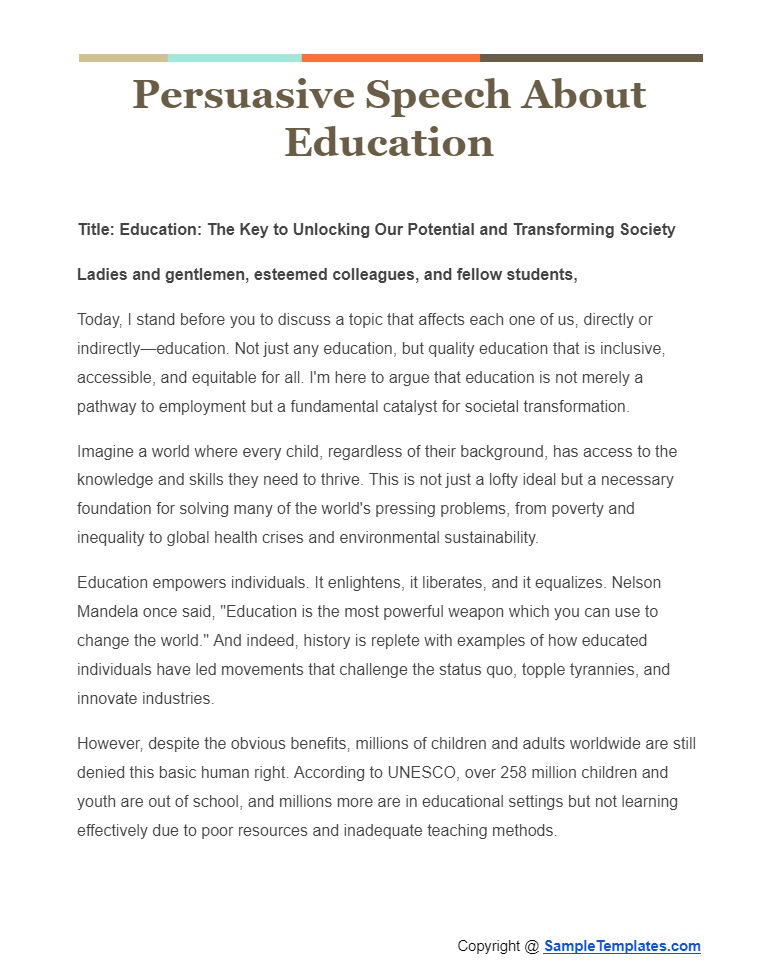
2 Minutes Persuasive Speech
Ladies and gentlemen,
Every minute, one garbage truck of plastic is dumped into our oceans. This shocking fact alone should compel us all to take immediate action against one of the most pervasive environmental threats of our time: single-use plastics.
Why should we care? Because plastic pollution does more than just litter our beautiful landscapes and oceans. It poses a severe risk to wildlife, disrupts human health through the food chain, and creates unsustainable waste management challenges. Picture this: by 2050, scientists estimate there will be more plastic by weight in the ocean than fish. Do we really want to be responsible for turning our oceans into plastic soups?
The solution starts with us, the consumers. By refusing single-use plastics and opting for reusable alternatives, we have the power to drive change. Imagine if every one of us stopped using plastic straws, bags, and bottles. The impact would be profound. Businesses would shift to greener alternatives, and less plastic waste would end up in our environment.
But action must also come from above. We need policies that restrict plastic production, promote recycling, and hold manufacturers accountable for the environmental impact of their products. It’s not just about cleaning up; it’s about stopping the problem at its source.
I urge each of you to consider the role you play in this environmental crisis. Reduce, reuse, and insist on regulations that will help manage and ultimately eliminate single-use plastics. Let’s choose a cleaner, healthier planet—not just for our generation but for every future one. It’s time to act, not tomorrow, not next week, but today.
Thank you.
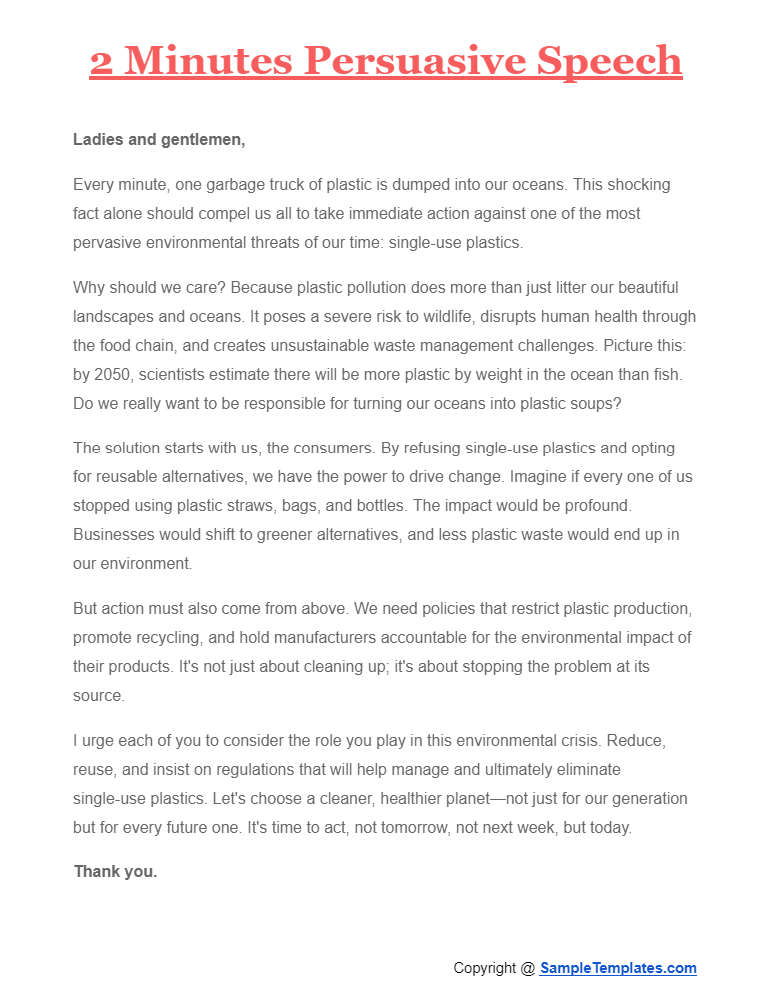
Persuasive Speech For Social Media
Ladies and gentlemen,
Today, I stand before you to discuss an issue that affects us all, either directly or indirectly: the use of social media. In this digital age, social media platforms have woven themselves into the fabric of our daily lives, shaping how we communicate, interact, and perceive the world around us. While these platforms bring us closer to those far away, provide endless entertainment, and empower us to express ourselves, they also come with significant responsibilities and risks that we must not ignore.
First, let us acknowledge the benefits. Social media can be a powerful tool for social change, enabling us to mobilize for causes, spread important messages, and make our voices heard. It has democratized information, making it accessible to everyone with internet access. But as we revel in this freedom, we must also consider the consequences of our digital footprints.
The dark side of social media reveals itself in various forms. Cyberbullying, misinformation, and privacy breaches are rampant, affecting mental health and leading to real-world implications. Studies have shown an increase in anxiety and depression linked to excessive social media use. Moreover, the spread of false information can disrupt societies, manipulate opinions, and even influence elections.
Therefore, I urge each one of you to practice and promote responsible use of social media. This means thinking critically about the information we share and consume. It involves setting boundaries for ourselves and respecting the privacy of others. It requires us to be kind and considerate, recognizing that behind every profile is a human being with feelings and vulnerabilities.
Let us also demand more from those who manage these platforms. Social media companies must do better at enforcing policies that protect their users and ensure a safe environment. It is their responsibility to prevent their platforms from becoming breeding grounds for hate and falsehood.
In conclusion, while social media continues to evolve, let us not passively allow it to shape our values and behavior. Instead, let’s take charge of how we engage with these platforms. Let’s use social media not just to connect, but to uplift and educate. Let’s be models of digital citizenship, advocating for a space that respects all users and fosters positive, meaningful interactions.
Let us not forget that with great power comes great responsibility. The power of social media is immense, and it is up to each one of us to ensure it is wielded wisely.
Thank you.
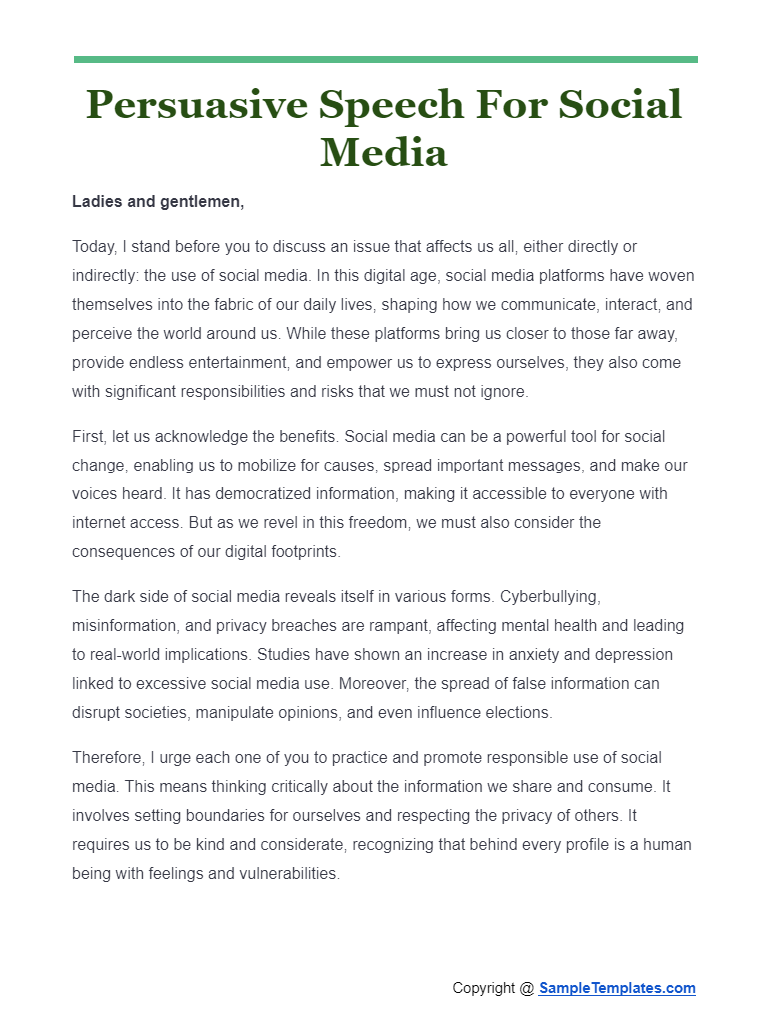
Browse More Templates On Persuasive Speech
Persuasive Speech Outline Template
This Sample Speech Outline Example concerns adults who work together to persuade a group on the point of similarity. It uses Monroe’s motivated sequence of giving a background speech preparation, introduction, body, conclusion, and reference.
Persuasive Speech Topics Example
The persuasive topics are laid out for both the teacher and the taught. It consists a list of themes that can help in writing a perfect debate oriented speech.
Tips For Delivering Your Persuasive Speech
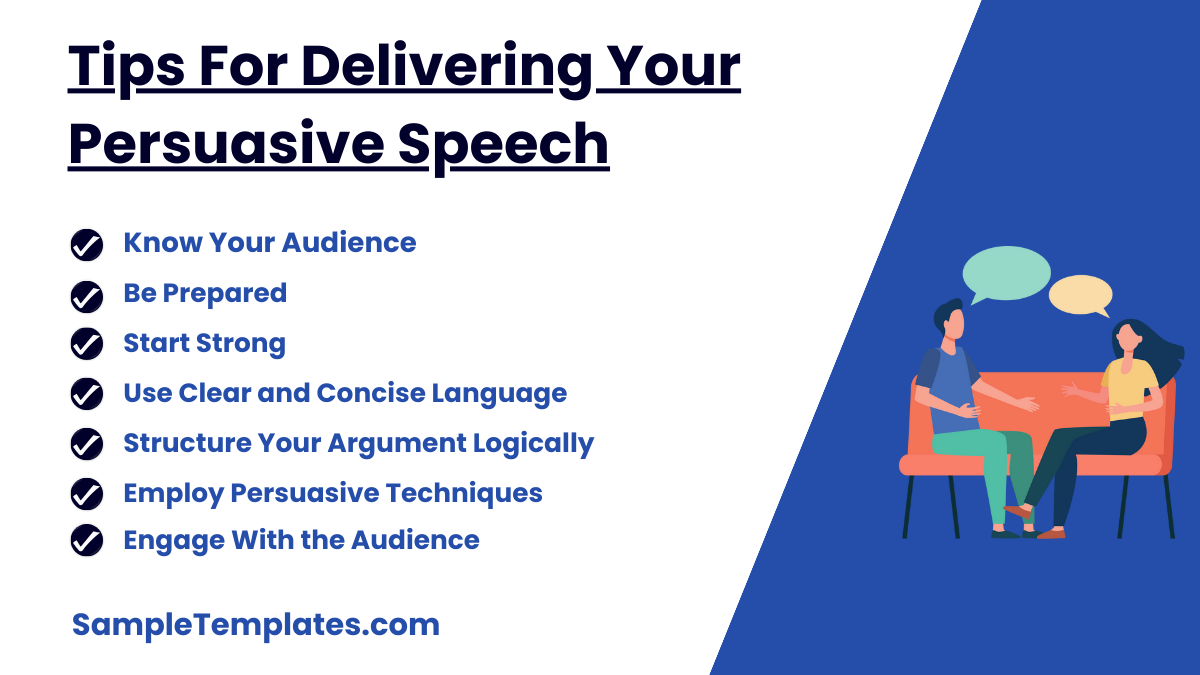
Delivering a persuasive speech effectively is crucial for making a strong impact on your audience. Here are some practical tips to help you deliver your speech convincingly:
1. Know Your Audience
- Understand who you are speaking to. What are their interests, beliefs, or potential biases? Tailoring your speech to resonate with your audience can significantly increase its effectiveness.
2. Be Prepared
- Familiarize yourself with your material. Practice your speech multiple times to ensure you know it well and can deliver it smoothly without relying too heavily on notes.
3. Start Strong
- Capture your audience’s attention from the beginning with a powerful opening statement. This could be a startling statistic, a provocative question, or a compelling anecdote.
4. Use Clear and Concise Language
- Avoid jargon and overly complex language. Keep your message clear and straightforward, making it accessible to your audience.
5. Structure Your Argument Logically
- Organize your speech in a logical sequence: introduce the problem, provide evidence, and conclude with a solution or call to action. Make sure each point builds on the last.
6. Employ Persuasive Techniques
- Use rhetorical devices such as repetition, parallelism, and the rule of three. Appeal to logic through data and evidence, and to emotion through stories and personal anecdotes.
7. Engage With the Audience
- Make eye contact, ask rhetorical questions, and use gestures to keep the audience engaged. Show enthusiasm and conviction; your passion can be contagious.
8. Use Visual Aids
- Support your points with visual aids if possible, such as slides, graphs, or images. This can help reinforce your message and make it more memorable.
9. Manage Your Pace and Tone
- Vary your speech pace and tone to emphasize key points and keep the audience interested. Avoid monotonous delivery.
10. Prepare for Questions
- Anticipate questions or objections the audience might have. Prepare thoughtful responses to strengthen your position and show your expertise and credibility.
11. Practice Good Timing
- Time your speech during rehearsals and adjust accordingly to fit within the allotted time. Keeping within the time limit respects your audience’s time and keeps their attention.
12. Close Effectively
- End with a strong conclusion that reinforces your main message and leaves a lasting impression. A call to action is often effective in persuasive speeches as it gives the audience a clear direction after listening to your argument.
By following these tips, you’ll be better equipped to deliver a persuasive speech that is engaging, memorable, and effective, driving home your points with clarity and conviction.
Sample Persuasive Speech Essay
This mostly concerns students writing essays example trying to make their speech stand apart in persuasion. It discusses the facets of the topic in points while establishing the statement with reference.
How do Such Speeches Appeal to a Greater Audience on Persuasion?
Persuasive Speech Samples in the whole sector deals with a given topic that reaches out to the listeners or readers of the whole thereby shattering their bubble of wrong illusions while bringing out a contrasting and striking reality. It follows a basic format of presenting out a paper by Monroe’s Motivated Sequence.
But, when the target audience becomes a bigger sphere, nations take up the responsibility of letting them know the importance of a certain matter. For example, talking about HIV/AIDS, is an issue of national interest. The primary persuasive speech deals mostly in this sector of mass persuasion.
Persuasive Speech Introduction Template
A persuasive introduction at first lays out ways of us getting affected and thus, should build upon this point of being correct while supporting his statements with argumentative counteracts.
Sample Motivated Persuasive Speech Essay Template
These speeches deal with the basic and vast idea of targeting the whole audience. As it addresses a point of national discomfort thus, it benefits them on a personal level.
Ideas For Your Persuasive Speech
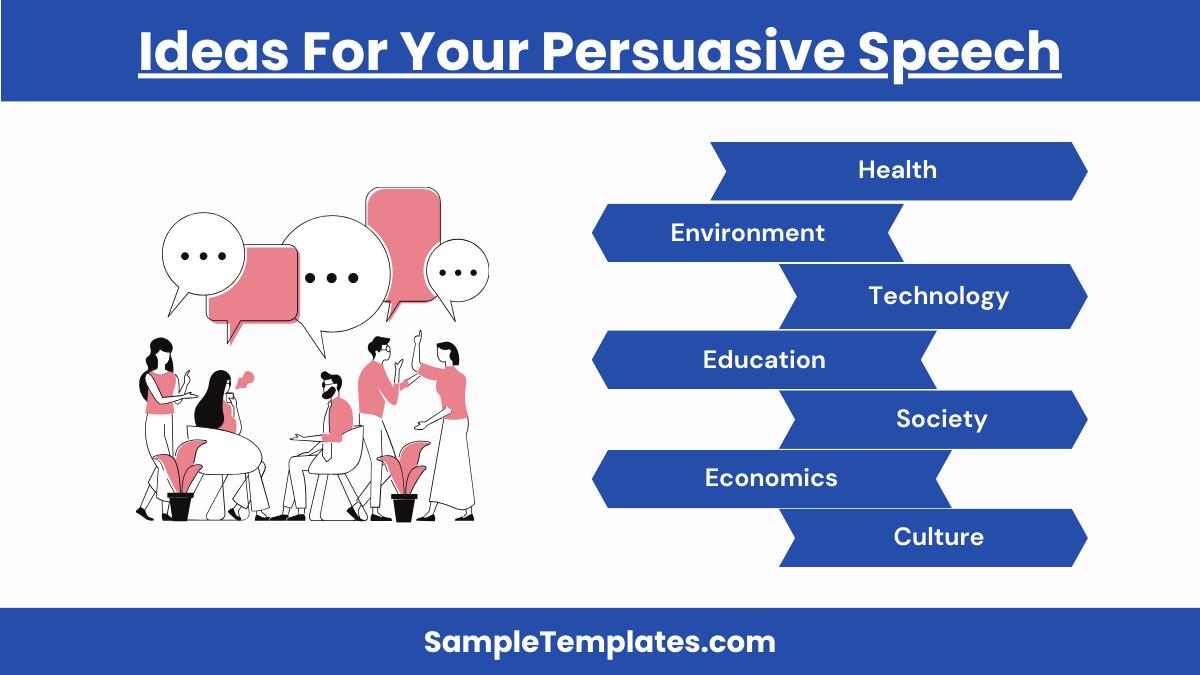
Crafting a persuasive speech that captivates and convinces your audience can be challenging. To help you get started, here are a variety of topics across different areas that might inspire your next speech:
1. Health and Wellness
- The benefits of a plant-based diet: Argue for the health, environmental, and ethical benefits.
- Mandatory vaccinations: Discuss the importance of vaccines in public health and why they should be mandatory.
- Mental health education in schools: Advocate for comprehensive mental health curriculums in educational institutions.
2. Environment and Sustainability
- Banning single-use plastics: Make a case for how banning plastics can drastically reduce pollution.
- Climate change is everyone’s business: Persuade your audience that every individual has a role in combating climate change.
- Support for renewable energy: Argue for increased governmental and private sector investment in renewable energy sources.
3. Technology and Innovation
- Regulating artificial intelligence: Discuss the need for strict regulations to prevent unethical uses of AI.
- The impact of social media on teenagers: Argue whether social media networks do more harm than good to young users.
- Privacy versus security in the digital age: Debate the balance between maintaining privacy and ensuring national security.
4. Education
- Free college education: Advocate for free tertiary education to improve societal benefits and reduce income inequality.
- The importance of arts education: Argue for increased funding and support for arts programs in schools.
- Homeschooling vs. traditional schooling: Which is more effective and why?
5. Social Issues
- Gun control laws: Argue for stricter gun control to reduce violence.
- Legalization of marijuana: Discuss the benefits of legalizing marijuana, such as reduced crime rates and increased tax revenue.
- Immigration reform: Advocate for or against stricter immigration laws.
6. Economics and Business
- Minimum wage increase: Argue the economic and social benefits of raising the minimum wage.
- The gig economy is a double-edged sword: Discuss the advantages and disadvantages of gig work.
- Corporate responsibility: Persuade businesses to invest in ethical practices.
7. Culture and Society
- Cultural appropriation vs. appreciation: Define the line between the two and discuss its significance.
- Animal rights and experimentation: Argue why animal testing should be banned.
- The death penalty: Make a case for or against its abolition.
These topics can be tailored to your specific interests and audience, and they offer a rich ground for argumentation and persuasion. Remember to research thoroughly and present clear, evidence-backed arguments to effectively persuade your audience.
Driving Persuasive Speech Template
What is the Perfect Way of Writing a Persuasive Speech?
A Speech Outline Samples should blindly follow the basic steps of writing which first starts with hooking the attention of the audience through an engaging introduction. Then, it should mention why and what he is saying needs to be implemented. Then comes the solution of the problem which the orator conveys, the solution should totally satisfy the listener.
Once the part is completed, the speaker should give the listeners a proper visualization of how his implementation is helpful for all and one. The whole speech ends with the action of the plan. These help in the better functioning of the writer’s mind.
Personal Persuasive Speech Format
Informative Persuasive Speech Template
Persuasive speech deals with bringing about a point or matter of discussion in front of the readers or listeners. It helps in the high functioning of a mind. Informative Speech Examples as the word suggest are highly informative as it regards a greater issue and is surely food for thought.
How do I start my persuasive speech?
Start your persuasive speech with a strong hook like a surprising statistic, a provocative question, or a vivid story to immediately grab the audience’s attention.
Can you use the word you in a speech?
Yes, you can use the word “you” in a speech to directly address and engage your audience, making your message more personal and compelling.
Can I use the word I in a persuasive essay?
Yes, you can use the word “I” in a persuasive essay to share personal experiences or opinions, which can help establish your credibility and make your argument more relatable.
What is push in persuasive writing?
“Push” in persuasive writing refers to using assertive and sometimes aggressive language to strongly advocate for your position, aiming to convince the audience by emphasizing urgency and importance.
In conclusion, through compelling arguments, vivid examples, and emotional appeal, this persuasive speech has aimed to sway opinions, inspire action, and ignite change. Let us embrace its message and strive for a better, more enlightened future.
If you have any DMCA issues on this post, please contact us.
Related Posts
Timetable
Training Evaluation Forms
Acceptance Speech
Scientific Reports Samples & Templates
Attendance List Samples & Templates
Sample Meeting Minutes Templates
Presentation Speech Samples & Templates
Ukulele Chord Chart Samples & Templates
Retirement Speech Samples & Templates
Weekly Schedule Samples & Templates
Contractual Agreement Samples & Templates
FREE 9+ Amazing Sample Church Bulletin Templates in PSD | PDF
Sample Business Card Templates
Sample Cashier Job Descriptions
Questionnaire Samples
